Numerical Simulation and Application of Transient Electromagnetic Detection Method in Mine Water-Bearing Collapse Column Based on Time-Domain Finite Element Method
Abstract
:Highlights
- The full-space TEM responses of different water columns were studied.
- The concept of “geometric gravity center” effect is proposed.
- This research has been proven in the field.
Abstract
1. Introduction
2. Fundamentals of TEM Based on TDFEM
2.1. Time-Domain Electromagnetic Field Equation
2.2. Vector Finite Cell Method Discretized to the Space Domain
2.3. Solution to a Forward Problem
2.3.1. Time Discretization
2.3.2. Boundary Condition Setting
2.3.3. Non-Uniform Meshing
2.4. Verification of Algorithm Accuracy
3. Numerical Simulation
3.1. Whole-Space Transient Electromagnetic Responses of Water-Bearing Collapse Column
3.2. Responses of Different Inclination Collapse Column
4. Practical Application
5. Discussion
6. Conclusions
- (1)
- Based on the TDFEM, it is discovered that the response law of the water-bearing collapse column under full-space conditions is as follows: After the current is switched off, the induced electromagnetic field in the collapse columns first always appear at the point nearest to the transmitting coil, and then progressively diffuses to the middle area and stabilizes; The smaller the minimum distance, the greater the magnetic induction strength.
- (2)
- The “geometric gravity center” effect is proposed after analyzing the collapsed column model’s response characteristics at various inclination angles and discovering that all models’ transient electromagnetic responses are ultimately concentrated close to the collapsed column’s geometric gravity center.
- (3)
- This research can advance the fundamental theoretical understanding of mine transient electromagnetic, enhance exploration technology, and raise the degree of data processing and interpretation for mine transient electromagnetism, all of which are crucial for increasing the detection precision and effectiveness of mine transient electromagnetism and extending its range of applications.
Author Contributions
Funding
Institutional Review Board Statement
Informed Consent Statement
Data Availability Statement
Acknowledgments
Conflicts of Interest
References
- Wang, C.; Cheng, Y. Role of coal deformation energy in coal and gas outburst: A review. Fuel 2023, 332, 126019. [Google Scholar] [CrossRef]
- Wang, X.; Wang, E.; Liu, X.; Zhou, X. Failure mechanism of fractured rock and associated acoustic behaviors under different loading rates. Eng. Fract. Mech. 2021, 247, 107674. [Google Scholar] [CrossRef]
- Wang, H.; He, M.; Zhang, Z.; Zhu, J. Determination of the constant mi in the Hoek-Brown criterion of rock based on drilling parameters. Int. J. Min. Sci. Technol. 2022, 32, 747–759. [Google Scholar] [CrossRef]
- Zuo, J.; Wu, G.; Du, J.; Lei, B.; Li, Y. Rock Strata Failure Behavior of Deep Ordovician Limestone Aquifer and Multi-level Control Technology of Water Inrush Based on Microseismic Monitoring and Numerical Methods. Rock Mech. Rock Eng. 2022, 55, 4591–4614. [Google Scholar] [CrossRef]
- Yang, F.; Pang, Z.; Duan, Z. Distinguishing between faults and coal collapse columns based on sediment dating: A case study of the Huainan coal field, China. Environ. Earth Sci. 2016, 75, 959. [Google Scholar] [CrossRef]
- Yao, B.; Wei, J.; Wang, D.; Ma, D.; Chen, Z. Numerical study on seepage property of karst collapse columns under particle migration. CMES Comput. Model. Eng. Sci. 2013, 91, 81–100. [Google Scholar]
- Wang, X.; Asem, P.; Hu, C.; Labuz, J.F. Microcracking in tensile fracture of a brittle rock. Eng. Fract. Mech. 2021, 251, 107789. [Google Scholar] [CrossRef]
- Xue, G.-Q.; Li, X.; Gelius, L.J.; Qi, Z.-P.; Zhou, N.-N.; Chen, W.-Y. A new apparent resistivity formula for in-loop fast sounding TEM theory and application. J. Environ. Eng. Geophys. 2015, 20, 107–118. [Google Scholar] [CrossRef] [Green Version]
- Xue, G.-Q.; Bai, C.-Y.; Yan, S.; Greenhalgh, S.; Li, M.-f.; Zhou, N.-n. Deep sounding TEM investigation method based on a modified fixed central-loop system. J. Appl. Geophys. 2012, 76, 23–32. [Google Scholar] [CrossRef]
- Yin, C.; Qi, Y.; Liu, Y. 3D time-domain airborne EM modeling for an arbitrarily anisotropic earth. J. Appl. Geophys. 2016, 131, 163–178. [Google Scholar] [CrossRef]
- Li, X.; Liu, W.-T.; Zhi, Q.-Q.; Zhao, W. Three-dimensional joint interpretation of nuclear magnetic resonance and transient electromagnetic data. Chin. J. Geophys. 2015, 58, 2730–2744. [Google Scholar]
- Chen, K.; Xue, G.Q.; Chen, W.Y.; Zhou, N.N.; Li, H. Fine and Quantitative Evaluations of the Water Volumes in an Aquifer Above the Coal Seam Roof, Based on TEM. Mine Water Environ. 2019, 38, 49–59. [Google Scholar] [CrossRef]
- Guoqiang, X.; Jingcun, Y. New development of TEM research and application in coal mine exploration. Prog. Geophys. 2017, 32, 319–326. [Google Scholar]
- Li, Y. Key Technologies for Dynamic Imaging of Disaster-Causing Concealed Water Bodies in Underground Coalmines Based on Transient Electromagnetic Method. Trait. Signal 2020, 37, 301–306. [Google Scholar] [CrossRef]
- Lin, G.; Dong, D.; Li, X.; Fan, P. Accounting for Mine Water in Coal Mining Activities and its Spatial Characteristics in China. Mine Water Environ. 2020, 39, 150–156. [Google Scholar] [CrossRef]
- Jiang, Z.; Liu, L.; Liu, S.; Yue, J. Response Characteristics of Water-Bearing Goafs for Surface-to-Underground Transient Electromagnetic Method. J. Environ. Eng. Geophys. 2019, 24, 557–567. [Google Scholar] [CrossRef]
- Khan, M.Y.; Xue, G.-Q.; Chen, W.-Y.; Boateng, C.D. Investigation of Groundwater In-rush Zone using Petrophysical Logs and Short-offset Transient Electromagnetic (SOTEM) Data. J. Environ. Eng. Geophys. 2020, 25, 433–437. [Google Scholar] [CrossRef]
- Shi, X.; Zhu, S.; Zhang, W. Study on the mechanisms and prevention of water inrush events in a deeply buried high-pressure coal seam-a case study of the Chensilou Coal Mine in China. Arab. J. Geosci. 2019, 12, 19. [Google Scholar] [CrossRef]
- Yin, H.; Zhao, C.; Zhai, Y.; Sang, S.; Zhao, H.; Li, S.; Li, H.; Zhang, W.; Zhuang, X. Application of comprehensive support techniques to roadway tunneling in vicinity of Ordovician carbonate confined aquifers under complicated tectonic conditions. Carbonates Evaporites 2020, 35, 4. [Google Scholar] [CrossRef]
- Kordy, M.; Wannamaker, P.; Maris, V.; Cherkaev, E.; Hill, G. 3-D magnetotelluric inversion including topography using deformed hexahedral edge finite elements and direct solvers parallelized on SMP computers—Part I: Forward problem and parameter Jacobians. Geophys. J. Int. 2016, 204, 74–93. [Google Scholar] [CrossRef]
- Wang, H.; Luo, Y. Algorithm of a 2.5 dimensional finite element method for transient electromagnetic with a central loop. Chin. J. Geophys.-Chin. Ed. 2003, 46, 855–862. [Google Scholar]
- HuaiFeng, S.; ShangBin, L.; Yang, Y. Crank-Nicolson FDTD 3D forward modeling for the transient electromagnetic field. Chin. J. Geophys.-Chin. Ed. 2021, 64, 343–354. [Google Scholar]
- Yang, Y.-J.; Wang, X.-B.; Liu, X.-J.; Mi, X.-L.; Mao, L. A three-dimensional transient electromagnetic data inversion method based on a time-frequency transformation. Appl. Geophys. 2020, 17, 361–376. [Google Scholar] [CrossRef]
- Jin, J.-M. The Finite Element Method in Electromagnetics; John Wiley & Sons: Urbana, IL, USA, 2015. [Google Scholar]
- Kuo, J.T.; Cho, D.-H. Transient time-domain electromagnetics. Geophysics 1980, 45, 271–291. [Google Scholar] [CrossRef]
- Pridmore, D.; Hohmann, G.; Ward, S.; Sill, W. An investigation of finite-element modeling for electrical and electromagnetic data in three dimensions. Geophysics 1981, 46, 1009–1024. [Google Scholar] [CrossRef]
- Sugeng, F. Modeling the 3D TDEM response using the 3D full-domain finite-element method based on the hexahedral edge-element technique. Explor. Geophys. 1998, 29, 615–619. [Google Scholar] [CrossRef]
- Yin, C.; Qi, Y.; Liu, Y.; Cai, J. 3D time-domain airborne EM forward modeling with topography. J. Appl. Geophys. 2016, 134, 11–22. [Google Scholar] [CrossRef]
- Li, J.; Farquharson, C.G.; Hu, X. 3D vector finite-element electromagnetic forward modeling for large loop sources using a total-field algorithm and unstructured tetrahedral grids. Geophysics 2017, 82, E1–E16. [Google Scholar] [CrossRef]
- Li, J. 3D Numerical Simulation for Transient Electromagnetic Field Excited by Large Source Loop Based on Vector Finite Element Method. Ph.D. Thesis, Central South University, Changsha, China, 2011. [Google Scholar]
- Qi, Y. Time-domain Airborne Electromagnetic Simulation for Complex Medium. Ph.D. Thesis, Jilin University, Changchun, China, 2017. [Google Scholar]
- Berenger, J.P. A perfectly matched layer for the absorption of electromagnetic waves. J. Comput. Phys. 1994, 114, 185–200. [Google Scholar] [CrossRef]
- Luxian, L.; Songzhi, G.; Aiqin, W. The introduction and application of introduction and application. Adv. Mech. 2007, 150, 161–174. [Google Scholar]
- Jingtian, T.; Lincheng, Z.; Jinzhe, G.; Xiao, X. 3D frequency domain controlled source electromagnetic numerical modeling with coupled finite-infinite element method. J. Cent. South Univ. 2014, 45, 1251–1260. [Google Scholar]
- Blome, M.; Maurer, H.R.; Schmidt, K. Advances in three-dimensional geoelectric forward solver techniques. Geophys. J. R. Astron. Soc. 2010, 176, 740–752. [Google Scholar] [CrossRef] [Green Version]
- Chang, J.; Yu, J.; Su, B. Numerical simulation and application of mine TEM detection in a hidden water-bearing coal mine collapse column. J. Environ. Eng. Geophys. 2017, 22, 223–234. [Google Scholar] [CrossRef]
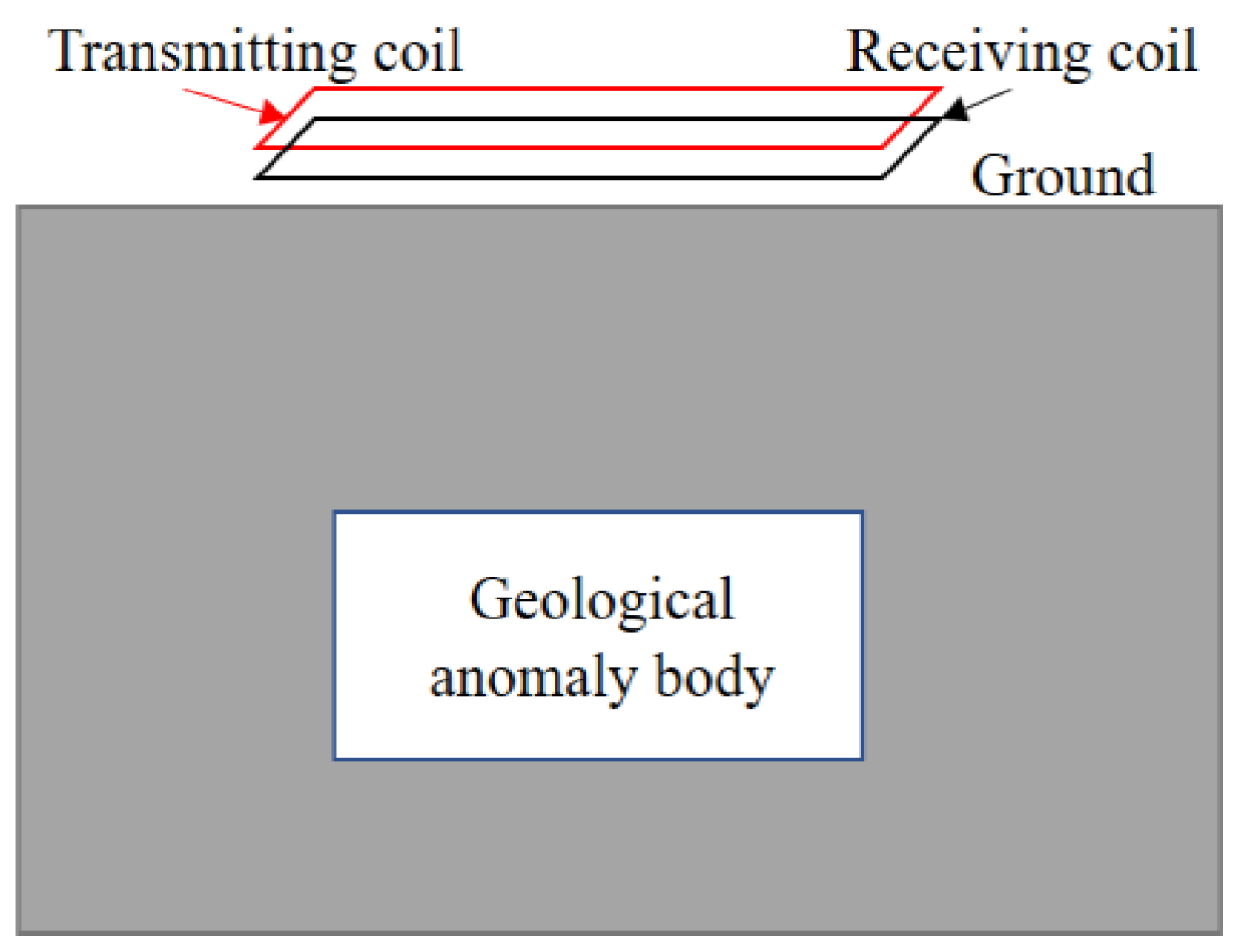
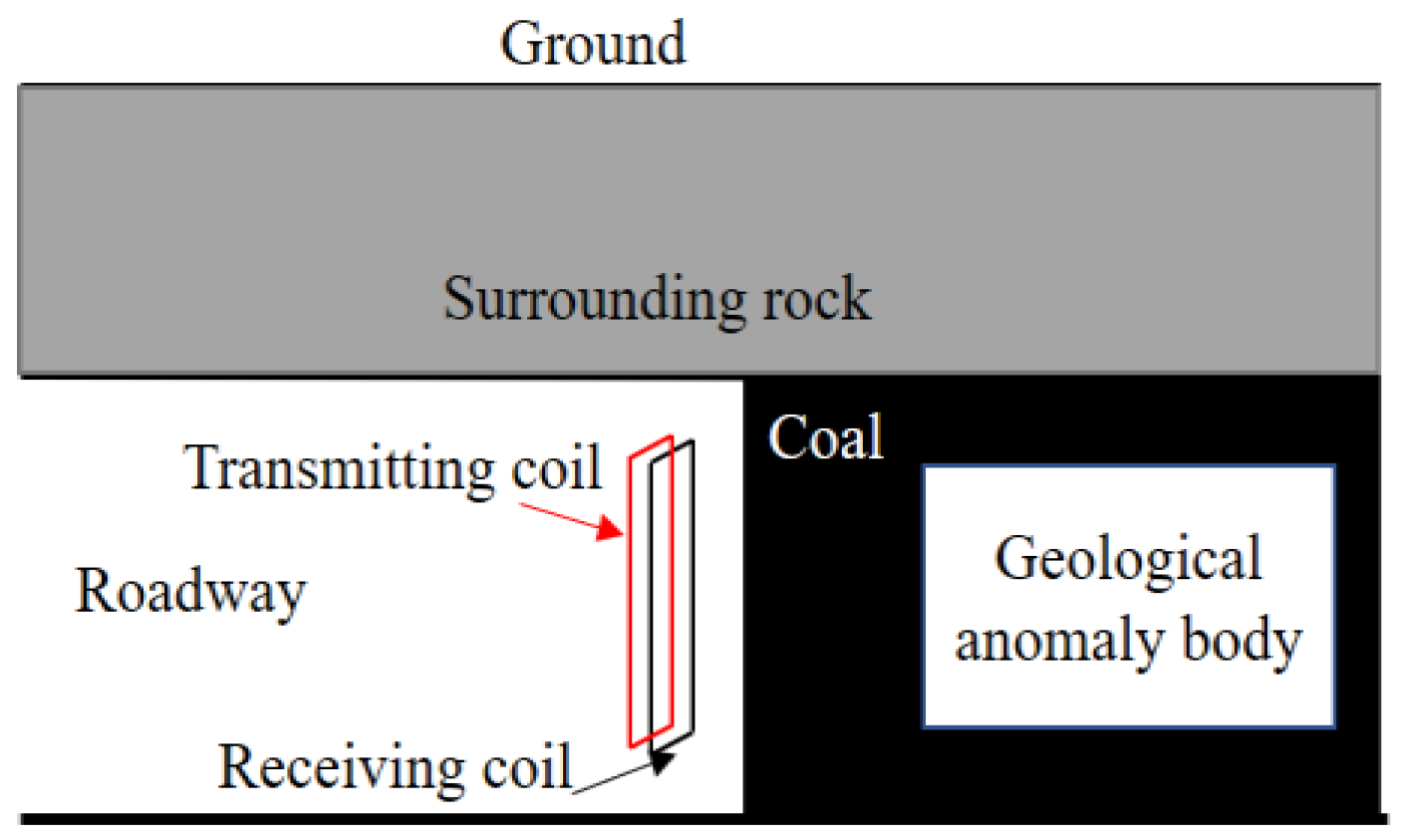
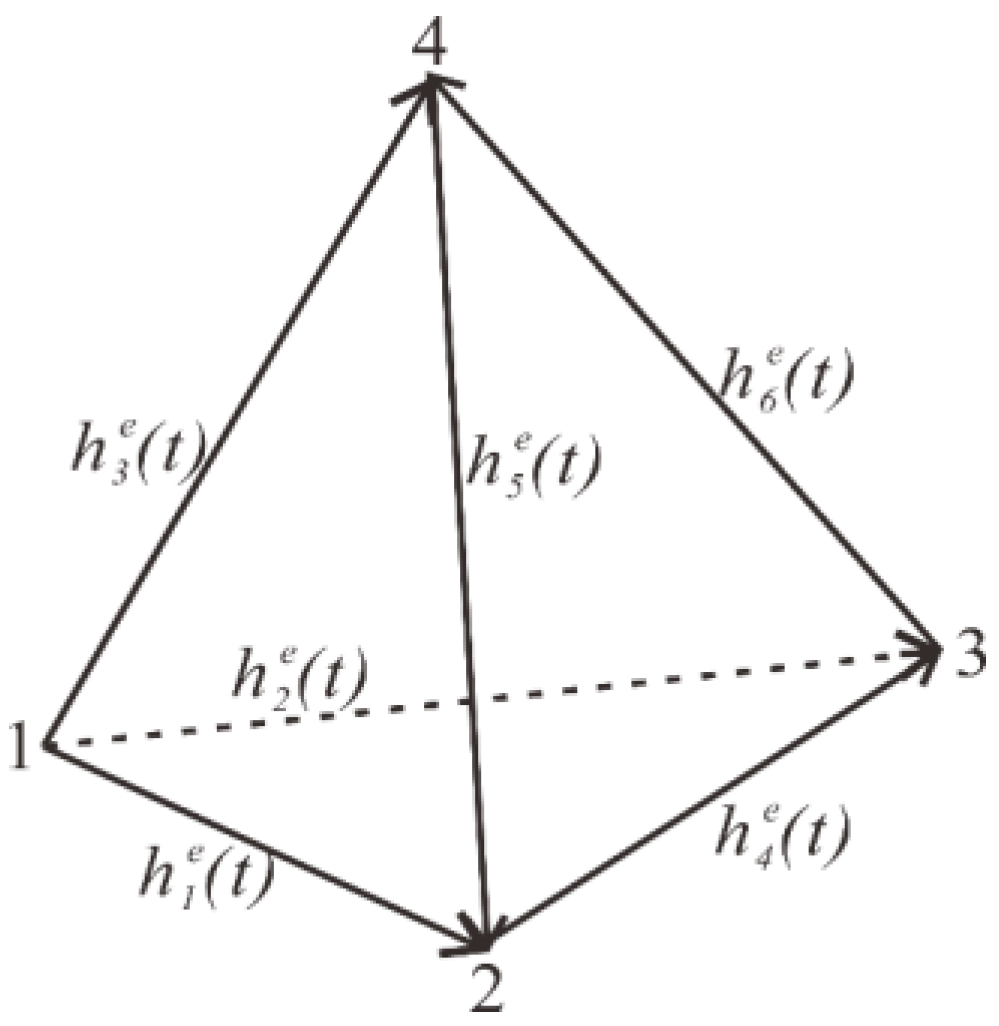

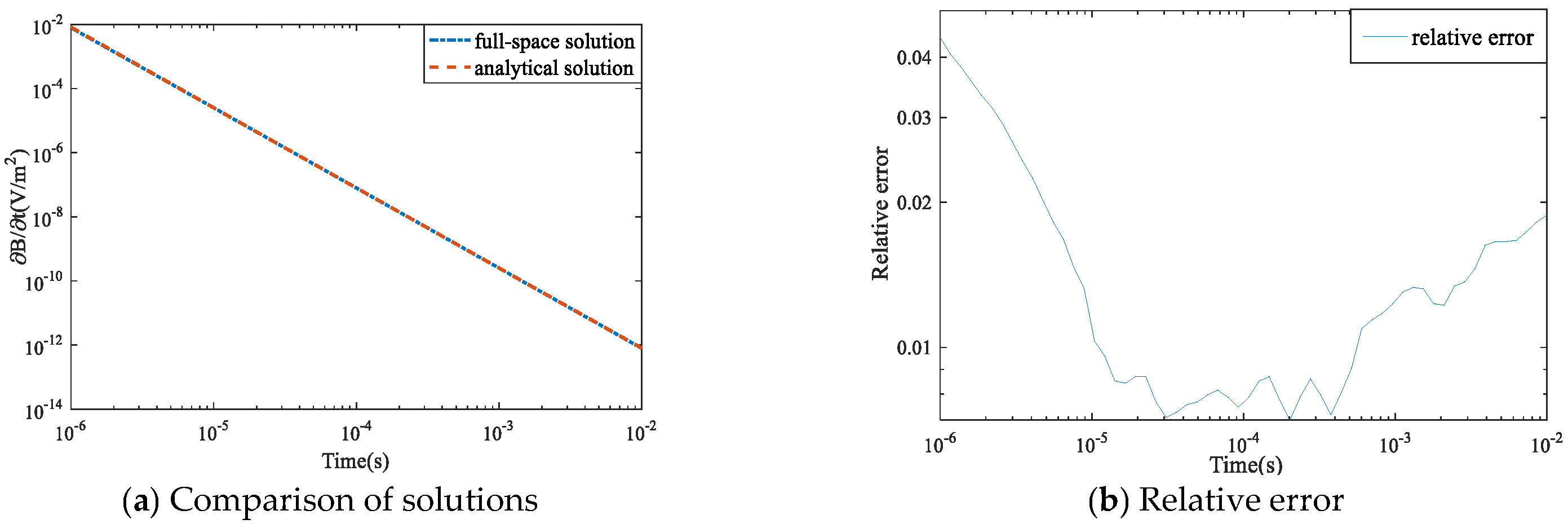
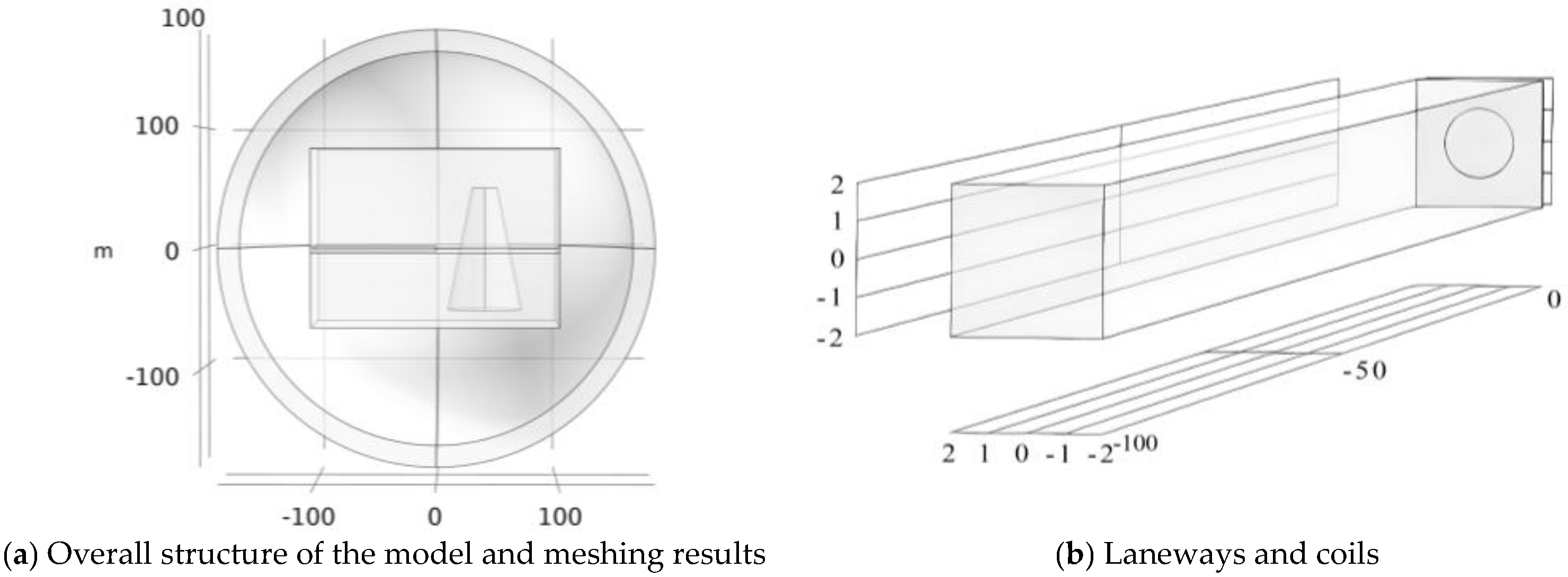
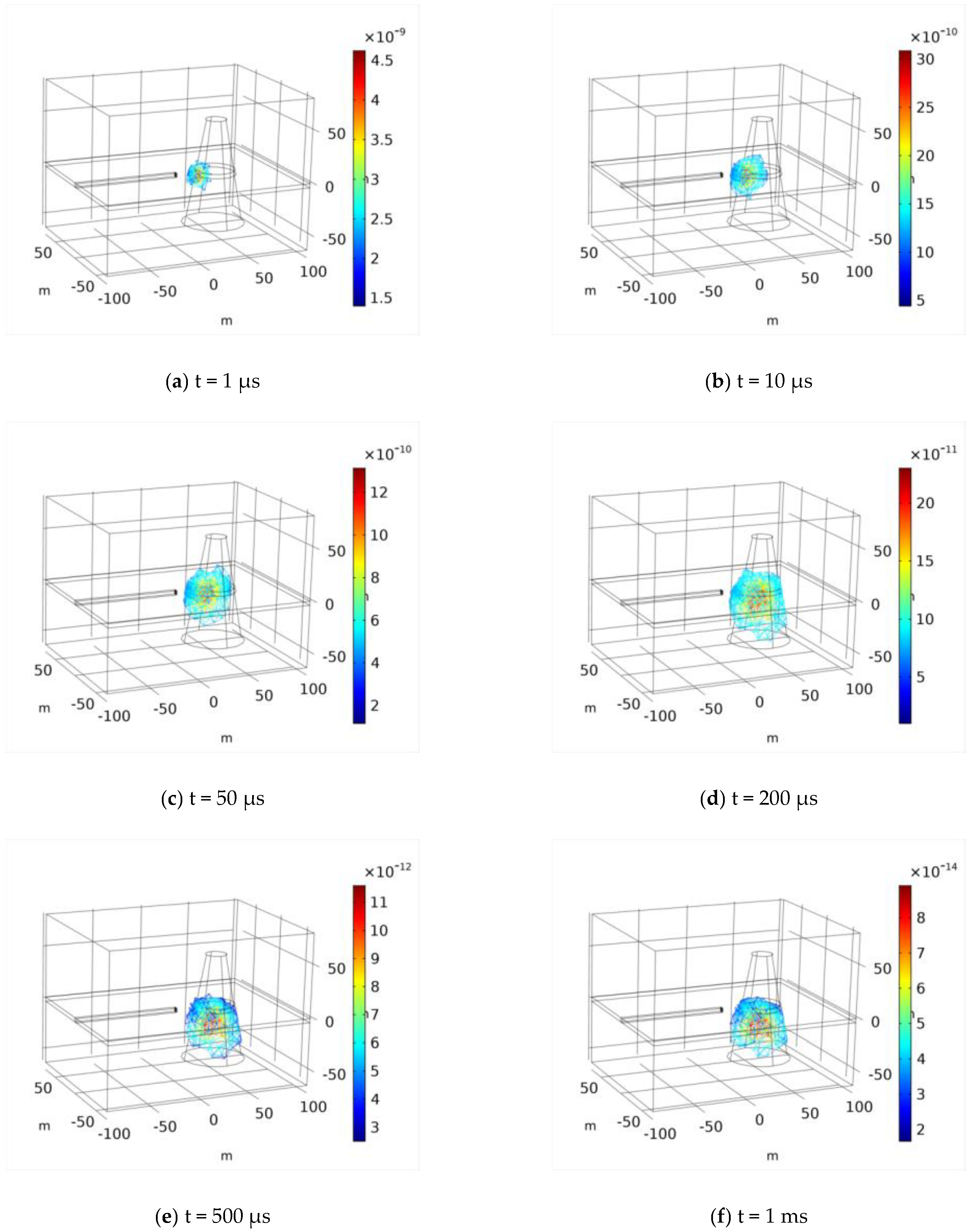
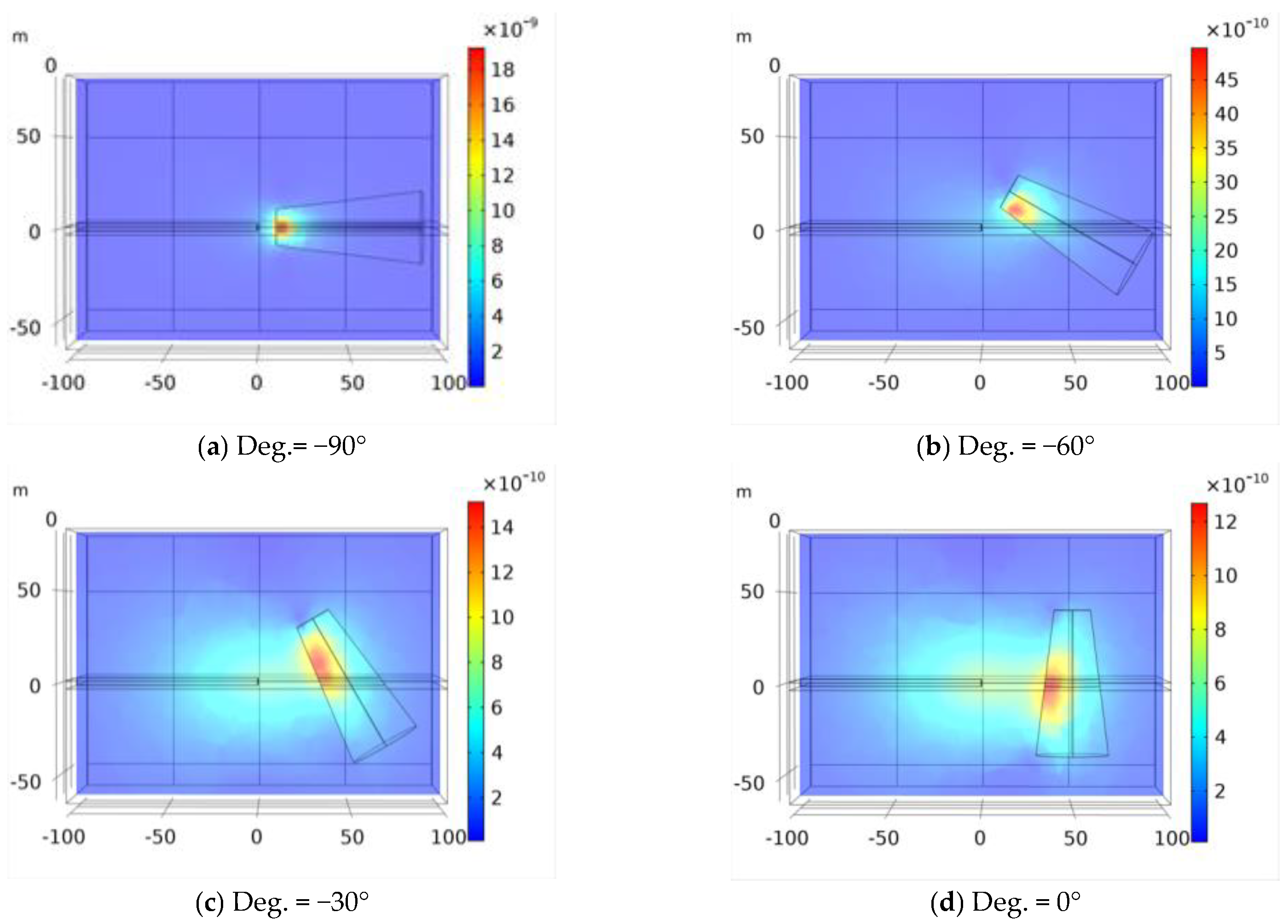
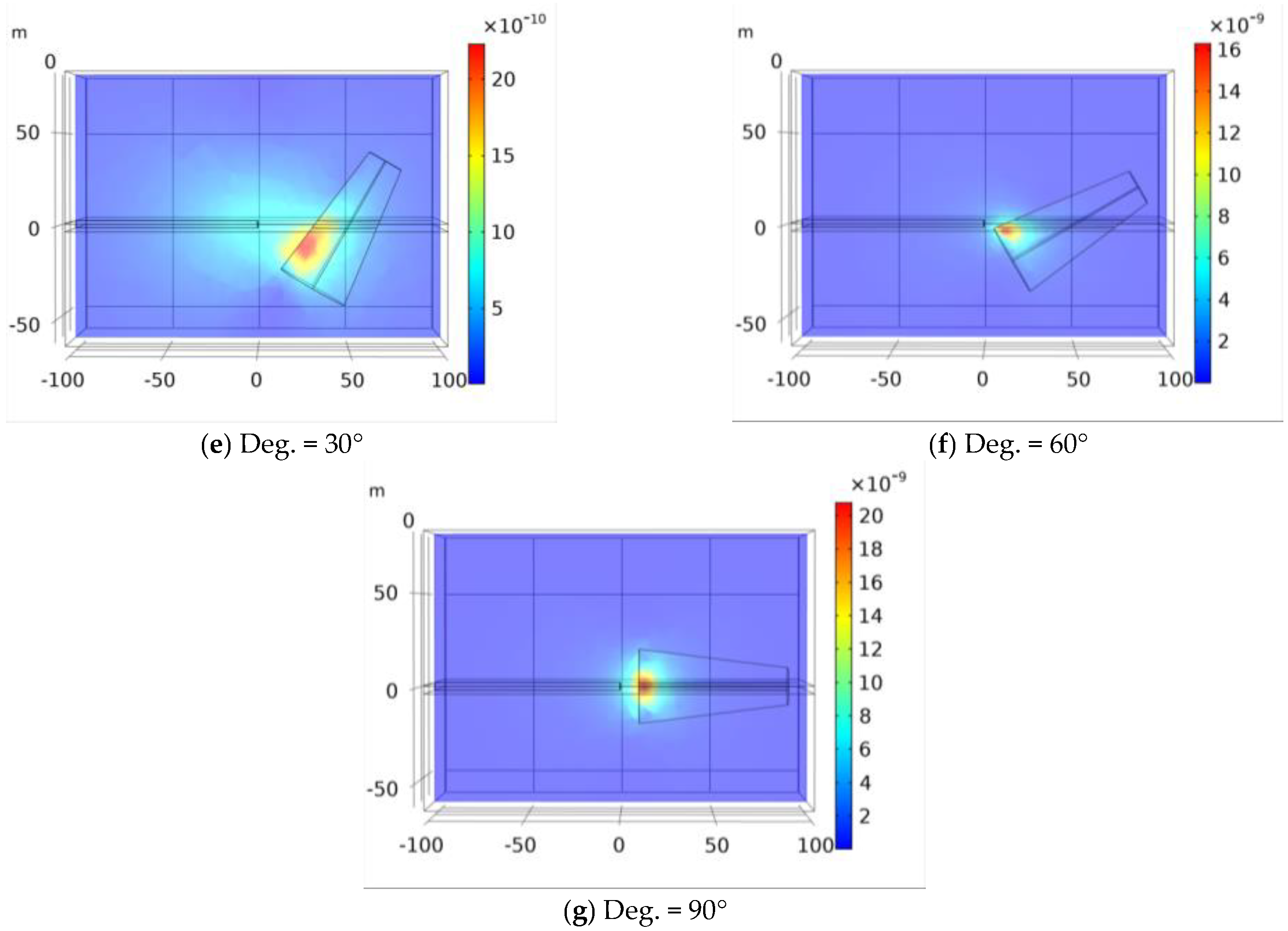
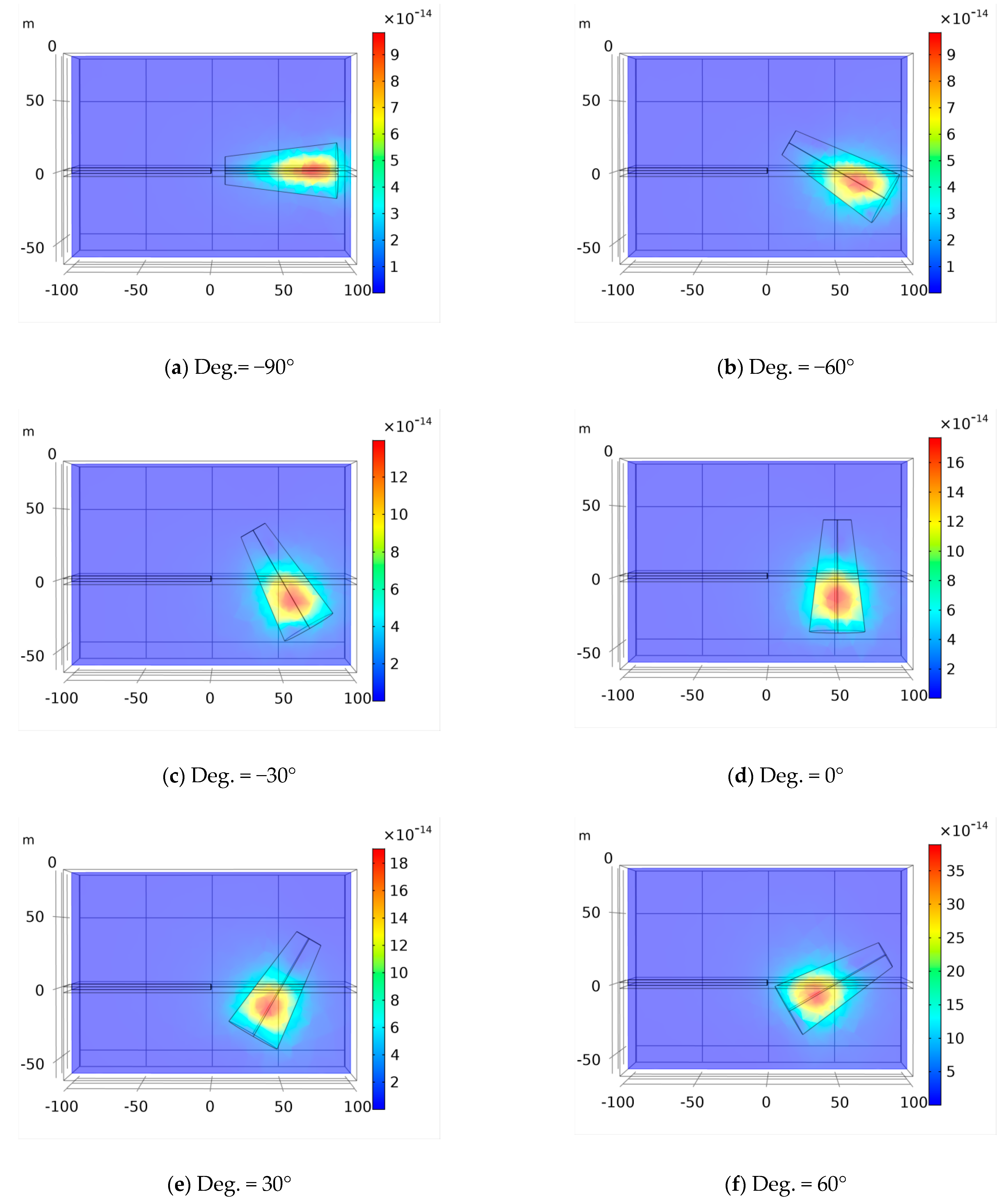


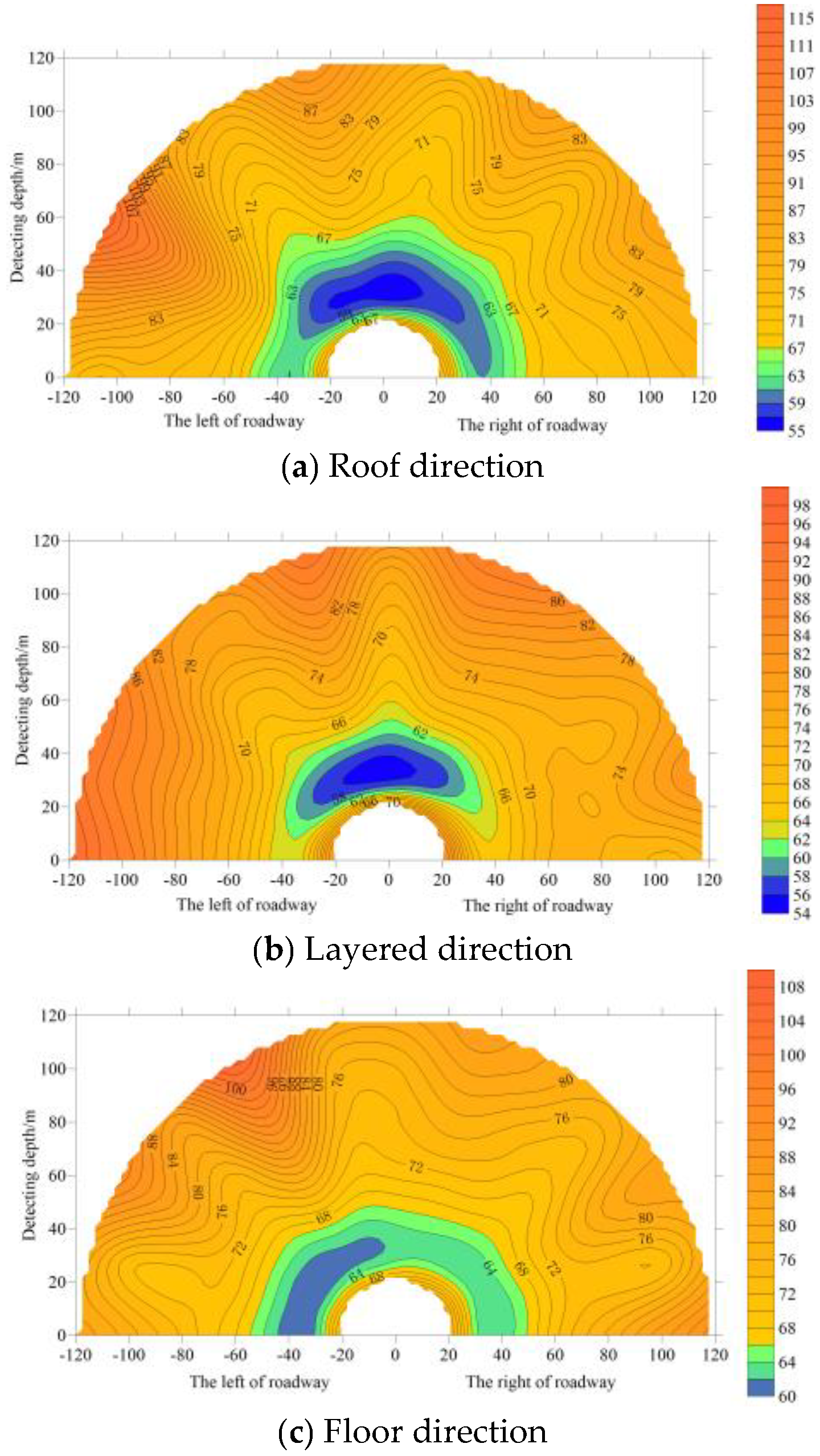

| Toward the Length (x)/m | Tending Length (y)/m | Thickness (z)/m | Apparent Resistivity (Ω·m) | |
|---|---|---|---|---|
| Roof | 200 | 150 | 80 | 100 |
| Coal seam | 200 | 150 | 4 | 50 |
| Floor | 200 | 150 | 60 | 100 |
| Radius of the Upper Surface/m | Radius of the Lower Surface/m | Height/m | Apparent Resistivity (Ω·m) | |
|---|---|---|---|---|
| Cylinder | 10 | 30 | 100 | 1 |
Publisher’s Note: MDPI stays neutral with regard to jurisdictional claims in published maps and institutional affiliations. |
© 2022 by the authors. Licensee MDPI, Basel, Switzerland. This article is an open access article distributed under the terms and conditions of the Creative Commons Attribution (CC BY) license (https://creativecommons.org/licenses/by/4.0/).
Share and Cite
Guo, C.; Tan, T.; Ma, L.; Chang, S.; Zhao, K. Numerical Simulation and Application of Transient Electromagnetic Detection Method in Mine Water-Bearing Collapse Column Based on Time-Domain Finite Element Method. Appl. Sci. 2022, 12, 11331. https://doi.org/10.3390/app122211331
Guo C, Tan T, Ma L, Chang S, Zhao K. Numerical Simulation and Application of Transient Electromagnetic Detection Method in Mine Water-Bearing Collapse Column Based on Time-Domain Finite Element Method. Applied Sciences. 2022; 12(22):11331. https://doi.org/10.3390/app122211331
Chicago/Turabian StyleGuo, Changfang, Tingjiang Tan, Liuzhu Ma, Shuai Chang, and Ke Zhao. 2022. "Numerical Simulation and Application of Transient Electromagnetic Detection Method in Mine Water-Bearing Collapse Column Based on Time-Domain Finite Element Method" Applied Sciences 12, no. 22: 11331. https://doi.org/10.3390/app122211331





